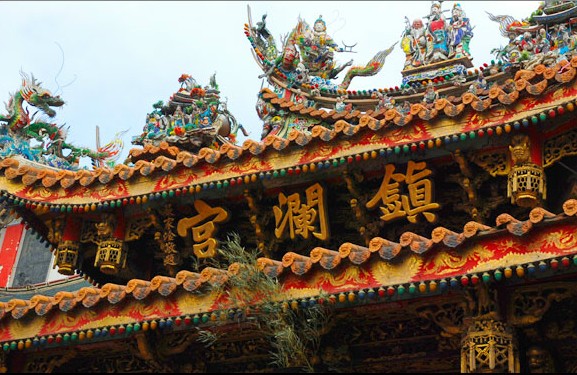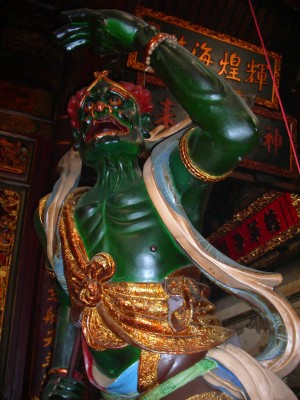| ||
| Mazu (s-Chinese: 妈祖; t-Chinese: 媽祖; pinyin: Māzǔ; Wade-Giles: Ma-tsu;literally "Mother-Ancestor"), also spelt Matsu, is the indigenous goddess of the sea who protects fishermen and sailors, and is invoked as the goddess who protects East Asians who are associated with the ocean. Her mortal name is Lin Moniang (s-Chinese: 林默娘; t-Chinese: 林默娘; pinyin: Lín Mòniáng). She is widely worshipped in the south-eastern coastal areas of China and neighbouring areas in Southeast Asia, especially Zhejiang, Fujian, Taiwan, Guangdong, and Vietnam, all of which have strong sea-faring traditions, as well as migrant communities elsewhere with sizeable populations from these areas. | ||
Popular names
| ||
Official titles
| ||
PersonAccording to legend, Lin Moniang was born in 960 AD (during the early Northern Song Dynasty) as the seventh daughter of Lin Yuan (林愿) on Meizhou Island, Fujian. She did not cry when she was born, and thus her given name means "Silent Girl." There are many legends about her and the sea. Although she started swimming relatively late at the age of 15, she soon became an excellent swimmer. She wore red garments while standing on the shore to guide fishing boats home, even in the most dangerous and harsh weather. According to legend, Lin Moniang's father and brothers were fishermen. One day, a terrible typhoon arose while they were out at sea, and the rest of her family feared that those at sea had perished. In the midst of this storm, depending on the version of the legend, she fell into a trance while praying for the lives of her father and brothers or dreamed of her father and brothers while she was sleeping or sitting at a loom weaving. In either story, her father and brother were drowning. However, Moniang's mother now discovered her and tried to wake her, and diverted Moniang's attention, causing her to drop her brother, who as a result drowned. Consequently, Moniang's father returned alive and told the other villagers that a miracle had happened. Other versions of the story relate four drowning brothers, with three returning and the fourth lost to her being revived (with no mention of a father). Mazu is usually depicted together with two guardian generals known as "Thousand Miles Eye" (千里眼, Qianli Yan) and "With-the-Wind Ear" (順風耳 Shunfeng Er). Their iconography, apart from resembling fierce demons can vary but "Thousand Miles Eye" is often red in color with two horns, while "With-the-Wind Ear" is green with one horn. They are said to have been two demons whom Mazu conquered and subdued, turning them into her own loyal guardians and friends. | ||
| ||
| Mazu herself is usually depicted wearing a red robe in paintings or murals, but in sculpture is always clothed in the jewel-festooned robes of an empress holding either a ceremonial tablet or a jewel staff, and wearing the easily recognized flat-topped imperial cap with hanging beads front and back. The tomb of Mazu in Matsu VillageThere are at least two versions of Lin Moniang's death. In one version, she died in 987 at the age of 28, when she climbed a mountain alone and flew to heaven and became a goddess. Another version of the legend says that she died at age 16 of exhaustion after swimming far into the ocean trying to find her lost father and that her corpse later washed ashore on Nankan Island of the Matsu Islands.Buddhism and Taoism borrowed popular deities from each other in attempts to attract devotees to their temples. In an attempt to justify Mazu's presence in Buddhist temples, legends were circulated claiming that Mazu's parents prayed to Guan Yin for a son, but Guanyin answered their prayers with the birth of yet another daughter. It was then believed that Mazu was a reincarnation of Guanyin on earth, and it is Guanyin she is said to have been especially devoted to as a child. As a result, Mazu is recognized and respected in both the Taoist and Buddhist pantheons of deities, while some Buddhists believe Mazu to be one of Guanyin's many manifestations. |
2009年11月24日 星期二
Da-Jia Ma-Zu 大甲 媽祖
訂閱:
張貼留言 (Atom)



沒有留言:
張貼留言